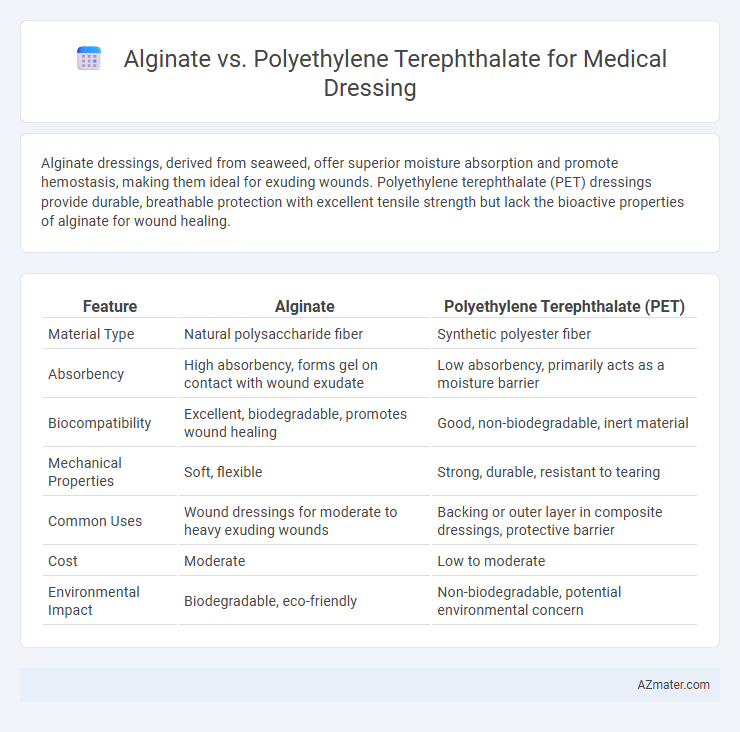Alginate dressings, derived from seaweed, offer superior moisture absorption and promote hemostasis, making them ideal for exuding wounds. Polyethylene terephthalate (PET) dressings provide durable, breathable protection with excellent tensile strength but lack the bioactive properties of alginate for wound healing.
Table of Comparison
| Feature | Alginate | Polyethylene Terephthalate (PET) |
|---|---|---|
| Material Type | Natural polysaccharide fiber | Synthetic polyester fiber |
| Absorbency | High absorbency, forms gel on contact with wound exudate | Low absorbency, primarily acts as a moisture barrier |
| Biocompatibility | Excellent, biodegradable, promotes wound healing | Good, non-biodegradable, inert material |
| Mechanical Properties | Soft, flexible | Strong, durable, resistant to tearing |
| Common Uses | Wound dressings for moderate to heavy exuding wounds | Backing or outer layer in composite dressings, protective barrier |
| Cost | Moderate | Low to moderate |
| Environmental Impact | Biodegradable, eco-friendly | Non-biodegradable, potential environmental concern |
Introduction to Alginate and Polyethylene Terephthalate Dressings
Alginate dressings, derived from seaweed, are highly absorbent and promote moist wound healing, making them ideal for moderate to heavily exuding wounds. Polyethylene terephthalate (PET) dressings, known for their durability and chemical resistance, serve primarily as protective barriers in wound management. Both materials offer distinct advantages in medical dressings, with alginate providing superior absorption and PET ensuring structural integrity and contamination prevention.
Material Composition and Sources
Alginate dressings are primarily composed of naturally derived calcium alginate fibers obtained from brown seaweed, offering excellent biocompatibility and absorbency. Polyethylene terephthalate (PET), a synthetic polymer produced through the polycondensation of terephthalic acid and ethylene glycol, is valued for its mechanical strength and durability in medical applications. The natural origin of alginate contrasts with the petrochemical synthesis of PET, influencing their biodegradability and interaction with wound environments.
Mechanisms of Action in Wound Healing
Alginate dressings promote wound healing by maintaining a moist environment and absorbing exudate through ion exchange with sodium in wound fluid, facilitating hemostasis and stimulating fibroblast activity. Polyethylene terephthalate (PET) dressings primarily provide structural support and a barrier against microbial invasion without actively interacting with wound exudate or cellular processes. The bioactive nature of alginate enhances the wound healing cascade, whereas PET serves as an inert physical scaffold, making alginate more effective in managing highly exudative wounds.
Absorbency and Moisture Management
Alginate dressings exhibit superior absorbency due to their highly hydrophilic structure, allowing rapid uptake of wound exudate and effective moisture retention. Polyethylene terephthalate (PET) dressings provide lower absorbency but excel in moisture vapor permeability, promoting breathability and preventing maceration. Optimal wound care often balances the high absorbency of alginate with the moisture management properties of PET for tailored healing environments.
Biocompatibility and Patient Comfort
Alginate dressings offer superior biocompatibility due to their natural polysaccharide composition, promoting low allergenicity and enhanced wound healing by maintaining a moist environment. Polyethylene terephthalate (PET), a synthetic polymer, provides durability and structural support but may present challenges in breathability and flexibility, potentially affecting patient comfort during extended wear. Clinical studies highlight alginate's superior absorption capacity and conformability, which contribute to reduced irritation and improved patient tolerance compared to PET-based dressings.
Antimicrobial Properties Comparison
Alginate dressings exhibit notable antimicrobial properties due to their ability to maintain a moist environment that promotes wound healing and hinders bacterial growth, often enhanced with incorporated silver ions or other antimicrobial agents. Polyethylene terephthalate (PET), primarily used as a robust, non-biodegradable backing material, lacks intrinsic antimicrobial activity and typically requires additional coatings or treatments to achieve similar antimicrobial effects. The superior natural bacteriostatic effect of alginate dressings makes them preferable in managing infected or high-exudate wounds compared to PET-based dressings.
Application Areas and Clinical Indications
Alginate dressings are highly effective in managing moderate to heavy exudate wounds such as pressure ulcers, diabetic foot ulcers, and surgical wounds due to their excellent absorbency and gel-forming properties, which promote a moist healing environment. Polyethylene terephthalate (PET) dressings, often used as outer film or backing layers, provide a waterproof, breathable barrier ideal for protecting superficial wounds, catheter insertion sites, and skin grafts while allowing moisture vapor transmission. Clinical indications for alginate dressings focus on draining wounds requiring moisture balance and autolytic debridement, whereas PET dressings are preferred for non-exudative wounds where protection from external contaminants and mechanical abrasion is critical.
Ease of Use and Dressing Changes
Alginate dressings offer superior ease of use due to their natural gel-forming properties that conform to wounds and absorb exudate efficiently, minimizing dressing changes. Polyethylene terephthalate (PET) dressings, while durable and moisture-resistant, require more frequent changes to prevent maceration and may be less adaptable to irregular wound shapes. The reduced frequency of dressing changes with alginate materials decreases patient discomfort and nursing time, making them preferable in wound care scenarios demanding frequent monitoring and minimal disruption.
Environmental Impact and Sustainability
Alginate medical dressings are derived from natural seaweed sources, making them biodegradable and environmentally friendly compared to polyethylene terephthalate (PET) dressings, which are petroleum-based and non-biodegradable. PET dressings contribute to microplastic pollution and persist in landfills for centuries, whereas alginate dressings decompose naturally and support sustainable waste management practices. The use of alginate aligns with circular economy principles, reducing carbon footprint and promoting ecological balance in healthcare applications.
Cost-Effectiveness in Medical Settings
Alginate dressings, derived from seaweed, offer cost-effective benefits in medical settings due to their natural absorbency and biodegradability, reducing the frequency of dressing changes and associated labor costs. Polyethylene terephthalate (PET) dressings, while durable and providing a strong barrier, often incur higher upfront expenses and may require more frequent replacement or additional wound management resources. Hospitals seeking optimized cost-efficiency often prefer alginate dressings for exudative wounds, balancing material costs with improved healing outcomes and reduced overall treatment duration.

Infographic: Alginate vs Polyethylene terephthalate for Medical dressing
 azmater.com
azmater.com